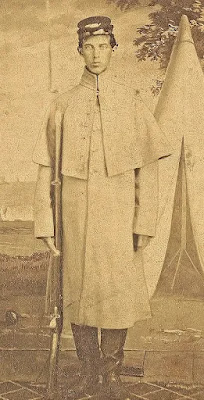Banner made for a Lincoln political club in 1860
by the Ladies of Clarence, New York
army. Sarah, daughter of a local politician who died when she was about 5 was probably chosen to honor her father.
She may have had several male friends in the local group, which was made up of young men. The grassroots organization included unusual and compelling imagery, most noticeably the eye quite "Wide Awake."
Wide-Awakes wore uniforms of shiny black capes and carried lanterns often attached to poles. A paramilitary organization, their purpose was promoting Lincoln's candidacy, establishing order while "Plug-Uglies" and other less peaceful gangs caused chaos at election rallies. And it gave the young men an identity, a fresh identity defined by their clothing.
In contrast to destructive gangs disrupting political events the Wide Awakes marched in orderly, well-drilled formation, offering protection for campaigners like Lincoln, William Seward and Cassius Clay.
Hake Auctions
Online auction photo of a man with a Lincoln/Hamlin badge
and the distinctive shiny black cape that Wide-Awakes wore.
Hartford parade in the home of the Wide Awakes.
Fireworks and lady spectators waving handkerchiefs.
Jon Grinspan, Curator of Political History at the Smithsonian Institution
has recently published Wide Awake: The Forgotten Force
That Elected Lincoln and Spurred the Civil War...
Edgar Smith Yergason (1840-1920)
Company B 22nd Connecticut Volunteers
Telling us about this 19-year-old (in soldier's uniform above he's about 21), a clerk in Talcott & Post's dry goods store in Hartford, Connecticut. In winter, 1860, although too young to vote for Lincoln, he had an idea for a political club. Being a lifelong designer he considered the visuals, realizing that a memorable outfit defined a man. He created a uniform, practical but odd, out of the shiny black cotton cambric in Talcott's stock. (Cambric is often used on the underside of chairs to keep the dust out.)
Talcott & Post specialized in interior fabrics.
Oil Cloth was one of their featured items.
Grinspan dates Edgar's idea for a Lincoln club to February, 1860.
Connecticut Wide Awakes, Connecticut Magazine, 1895.
James Chalker in the center with the taller cap was a tailor who sold uniforms.
By November 4th's election day tens of thousands of "Wide-Awakes" across the Northern states had fashioned capes out of shiny black cloth, undoubtedly with the support of female seamstresses, professional and amateur.
August, 1860
Collection of the Library of Congress
George Beza Woodward (1837-1927) Derry, New Hampshire
The lanterns dripped fuel, a practical
reason for a protective cape.
Keene, New Hampshire
While uniforms had much in common the banners seem quite varied, design up to the
local club---and the women who stitched them.
For all the banners carried in parades very few survive. The above
article from Bangor, Maine lists a few.
A pageant from the ladies of Akron, Ohio
Belfast, Maine
Three days before the election in Cleveland.
Election Eve, Worcester, Massachusetts
It would seem the role of women in the organization is the time-honored place of "Ladies ' Auxiliary."
Charlotte, Michigan
But newspaper articles tell a bit about women's Wide-Awake groups who paraded on horseback. Just a bit.
Agency, Iowa
Urbana, Illinois, October 1, 1860
St. Louis Globe, November 20, 1860
250 Wide-Awake Lincoln fans versus 30 Douglas grievers
Sarah's presentation and speech right before the war began may have been the high point of her
war experience, mostly spent in her teenage years in Wallingford in New Haven County about 30 miles south of Hartford.
She had no brothers or father in the fight as her father died soon after the 1850 census recorded him, his wife, three young daughters and a pair of servants.
Sarah married Frederick Royal Manning (1827-1898) becoming his second wife in 1868. She moved to Brooklyn, New York where he ran a dry goods store and they raised his children and their daughter and son.
A relative founded the Choate school on Atwater property in Wallingford.
1921 Obituary Meriden Journal
After Frederick's death Sarah returned to Connecticut where she lived into the 1920s.
Edgar Yergason also moved to New York after many years at Talcott & Post where he became a partner with a reputation for his interior designs. He opened his own firm on Fifth Avenue, winning commissions from the Harrison & McKinley administrations to decorate White House rooms.
Unknown Wide Awake
Collection Pamplin Historical Park
Men looking for a place in society do like to fraternize.
Smithsonian Institution Collection
In his introduction Grinspan writing in recent months compares the defining mood of 1860 to the current divisions some of the nostalgic see as the end of democracy, imagining a past of united Americans. See a preview here:






































No comments:
Post a Comment